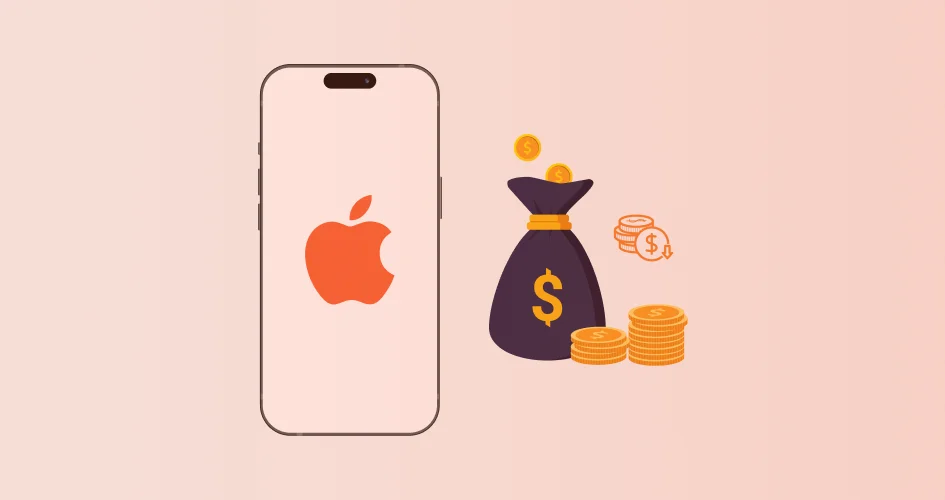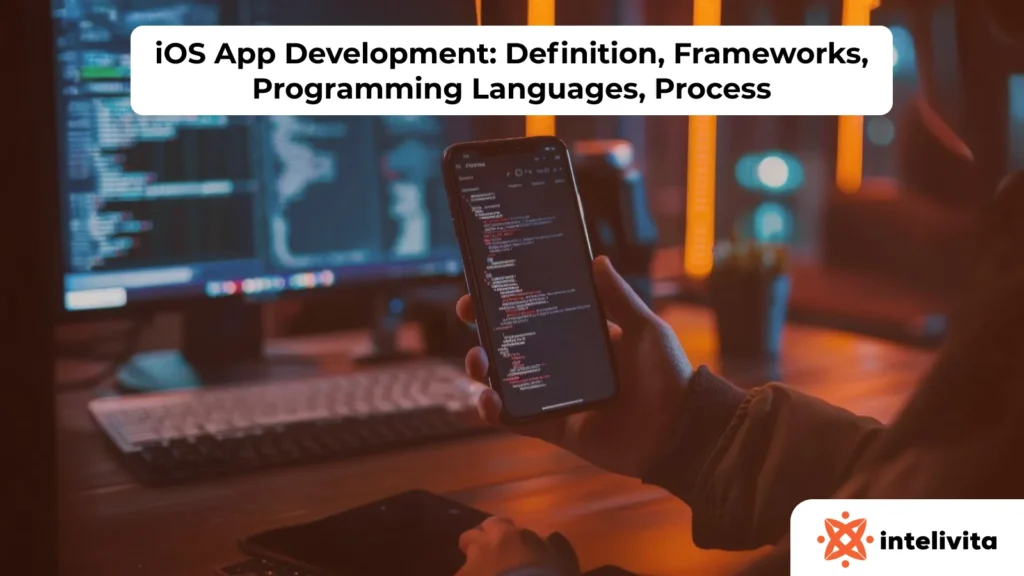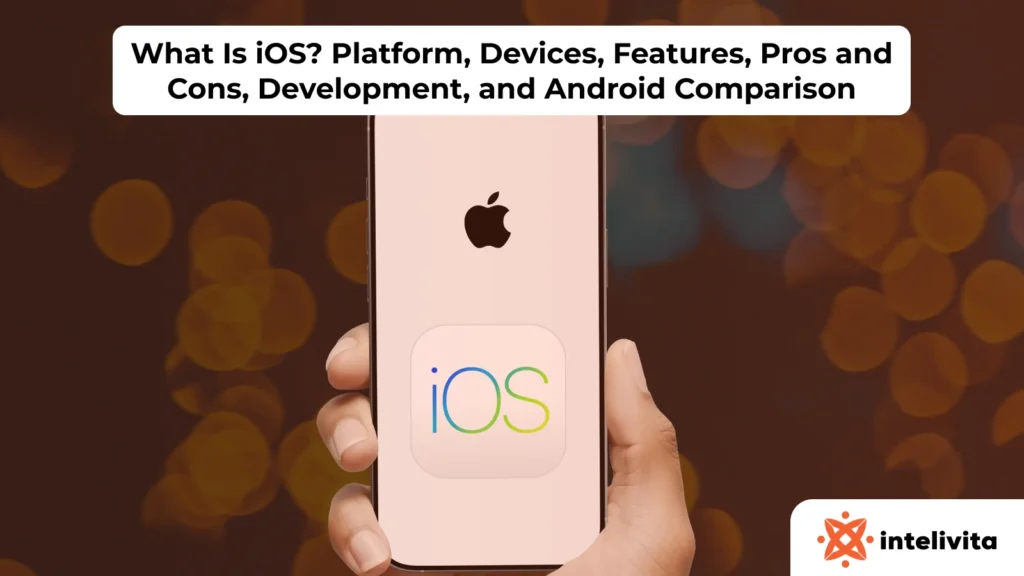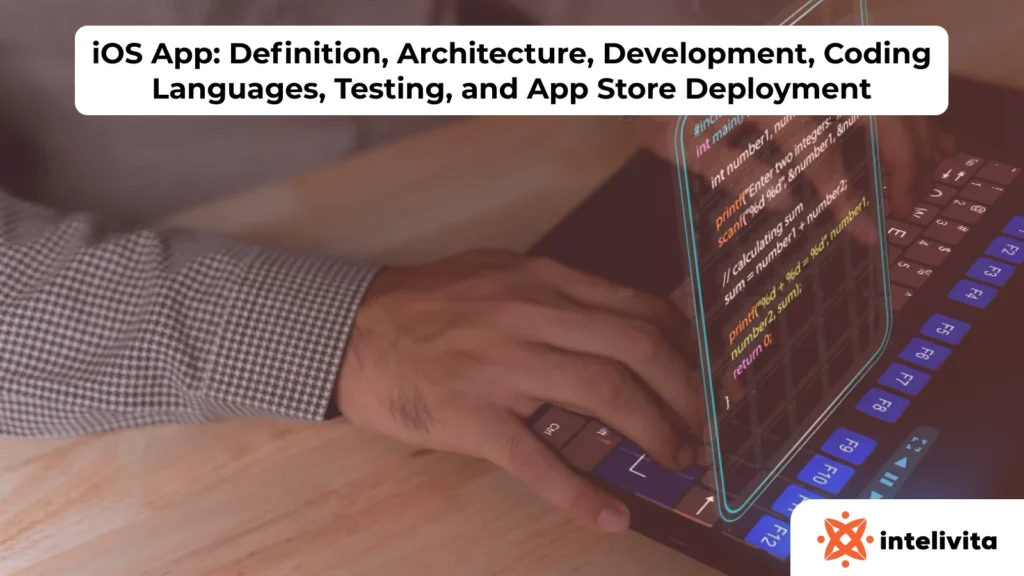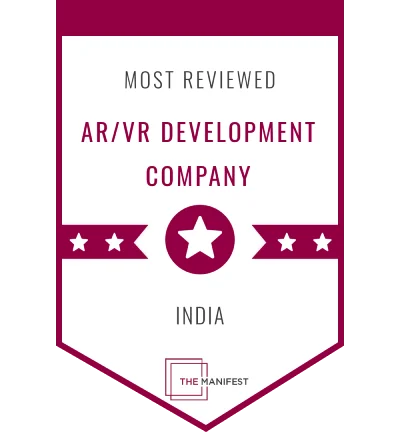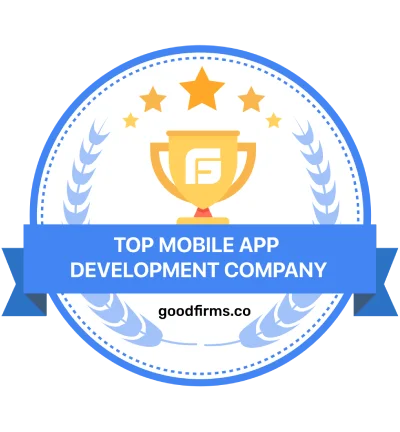Did you know that the App Store made $89.3 billion in revenue in 2023?
This shows how profitable it is for businesses.
With over 2.2 billion active iOS devices worldwide, you can’t afford to miss out on this opportunity to develop your own iOS app.
Remember, the longer you wait to do it, the more your competitors who have already launched theirs will benefit from dominating the market.
But, how much does it cost to make an iOS app?
In this article, we’ll cover everything you need to know about iOS app development costs, from the factors that affect it to tips on how to optimize the cost.
So, keep reading!
Factors Influencing iOS App Development Cost
These are several factors that affect how much it costs to develop an Apple app:
1. Project Complexity
The complexity of a project affects the cost of developing an iOS app.
More features require more time and resources for development.
Simple apps with basic functions are cheaper as they require less effort.
On the flip side, complex apps cost more due to advanced features like augmented reality, real-time data sync, and detailed database connections.
For example, IKEA’s Place app uses AR to display furniture in homes, which requires special skills and time.
Apps needing real-time data sync are also more costly, since they require a strong back-end system.
Here’s a rough cost estimation of iPhone apps based on their complexity:
| Project Complexity | Features | Estimated Cost |
| Simple | Basic UI, No API integration, Minimal features | $5,000 – $10,000 |
| Moderate | Custom UI/UX, API integration, Mid-level features | $10,000 – $50,000 |
| Complex | Advanced UI/UX, Multiple API integrations, Custom animations, Real-time features | $50,000 – $100,000+ |
| Very Complex | High-end UI/UX, Complex integrations, Sophisticated backend, High-level security | $100,000 – $500,000+ |
2. Design Requirements
Design requirements are another factor that influences Apple app development cost.
Custom UI/UX designs with unique animations and brand-specific elements can be more costly upfront.
That’s because skilled designers need extra time to create these special elements.
Despite the higher cost, these designs offer long-term benefits.
With improved UX design, you can enhance user interaction, increase conversion rates, and achieve better ROI.
Take a look at the Nest Learning Thermostat app’s unique UI, which mirrors the physical device.
This needs substantial design work.
By including these elements, developers can create functional and visually appealing apps effectively.
3. Team Composition and Location
The cost to create an app for the iPhone depends on the team’s structure and location of your iOS app development company.
Mobile app development services charge based on their experience, developers’ skills, and location.
For example, rates in the US start from $150, but in countries like Ukraine, they can be as low as $50.
The team’s size also affects costs. Larger teams finish projects faster but charge more, while smaller teams may be less expensive but take longer to complete the app.
To give you a better idea, here’s the estimated cost of iOS app developers based on their location and team size:
| Location | Small Team | Medium Team | Large Team |
| North America | $50,000 – $250,000 | $100,000 – $500,000 | $250,000 – $1,000,000+ |
| Europe | $30,000 – $150,000 | $70,000 – $300,000 | $150,000 – $600,000 |
| Asia | $10,000 – $70,000 | $20,000 – $150,000 | $50,000 – $250,000 |
4. Development Approach
There are two main approaches: native iOS development and cross-platform development.
Native iOS development uses Swift and the iOS SDK for iPhone and iPad apps to enhance performance and user experience.
In contrast, cross-platform development utilizes frameworks like React Native or Flutter for creating apps on both iOS and Android.
While native iOS development can be costly, cross-platform development saves money by using a single code but may not run as smoothly as native apps.
| Development Approach | Estimated Cost |
| Native | $20,000 – $100,000+ |
| Cross-Platform | $15,000 – $80,000+ |
5. Maintenance
App Maintenance services keep your app running smoothly, secure, and up-to-date.
Yearly maintenance typically ranges from 15-20% of the initial cost, covering hosting, servers, and services.
Bear in mind that neglecting maintenance can result in a poor user experience, reduced usage, and security vulnerabilities.
6. Testing and Quality Assurance
Testing and QA help find and fix problems before releasing the app.
This includes manual and automated techniques like unit testing, integration testing, and user acceptance testing.
Testing typically costs 5-20%, but it can vary depending on factors like app complexity, team size, and quality standards.
A good example is Spotify, which focuses on testing and QA to ensure a reliable and user-friendly experience on various iOS devices.
They use A/B tests to improve user experience, minimize post-launch problems, increase user satisfaction, and remain competitive in the App Store.
7. Marketing
Marketing costs for iOS apps include App Store optimization, paid ads, influencer collaborations, and public relations.
How much does it cost to market an iOS app?
The average Cost Per Install (CPI) for iOS apps is around $3.61 globally.
The marketing budget can vary depending on the app’s size and objectives.
A well-planned budget for a comprehensive marketing plan is crucial for both short-term and long-term app success.
8. Legal and Compliance
Legal and compliance costs cover data protection, privacy, intellectual property, and accessibility standards.
Compliance may require licenses and certifications, especially for healthcare or finance apps.
Getting professional legal advice can help navigate this complex area and reduce risks.
Despite the potential high costs, it protects your app from legal problems.
9. Unexpected Changes
Delays and changes can impact schedules and costs, and they mostly arise from client requests, technical issues, or external factors.
For example, if third-party tools need updates, it might take longer and cause delays.
Client requests or design changes can also make the development process longer.
To handle these situations, flexibility with the project plan and budget is crucial.
A reserve fund, typically 10-20% of the total budget, is often recommended.
But, the actual amount depends on the project’s complexity and risks.
How Much Does It Cost To Make an iOS App?
We will provide estimated expenses for creating an iOS app based on its developmental phase.
However, please note that final costs may vary due to different factors:
Research and Planning Costs
The initial step in making an iOS app is the research and planning stage, called the Discovery Phase.
It is the least costly phase, with a price range of $3,000 to $5,500.
| Research and Planning | |||
| Competitive Analysis | User Research & Interviews | Feature Definition & Prioritization | Project Scope & Timeline |
| $1,000 – $2,000 | $500 – $1,000 | $1,000 – $1,500 | $500 – $1,000 |
The cost will include these tasks:
- Competitive analysis: Researching competitor apps, analyzing features, UX, user reviews, and identifying market gaps.
- User research: Gathering user feedback and creating user profiles to inform app design.
- Feature definition and prioritization: Understanding user needs and business requirements, creating plans and layouts, and prioritizing essential elements.
- Project scope and timeline: Setting project goals, timelines, and limits, defining target audience, app functionality, and project plan details.
Design Phase Costs
The cost of the Design Phase includes creating the app’s visuals, user experience, and overall appearance.
It ranges from $2,000 to $50,000.
| Design Phase | |||
| User Interface (UI) Design | User Experience (UX) Design | Design System Development | Animation & Motion Design |
| $4,000 – $6,000 | $2,000 – $4,000 | $1,000 – $2,000 | $1,000 – $2,000 |
The budget will be spent on:
- User interface (UI) design: Creating detailed designs for app screens, including mockups, style guide development, and collaboration for design improvements.
- User experience (UX) design: Focusing on user-friendly navigation, layouts, and testing to ensure smooth experiences, accessibility, and prototype testing.
- Design system development: Creating reusable design elements for consistency and seamless handover to developers, including defining reusable pieces, documenting design details, and collaborating with developers.
- Animation and motion design: Creating engaging animations to boost user interactions and improve time spent on the app.
Development Phase Costs
The Development Phase is the longest and most expensive part of creating an iOS app.
The cost for this phase is estimated to be around $85,000.
| Development Phase | ||||
| Backend Development | iOS App Development | Quality Assurance & Testing | Project Management | DevOps & Deployment |
| $10,000 – $20,000 | $20,000 – $40,000 | $5,000 – $10,000 | $5,000 – $10,000 | $2,500 – $5,000 |
The cost of iphone app development will include these processes:
- Backend development: Handling server-side logic, APIs, database integration, and user authentication. Key activities include scalable architecture, API development, and database integration.
- iOS app development: Implementing UI, app functionality, backend integration, and data persistence. The tasks include backend integration, data storage implementation, and offline capabilities.
- Quality assurance and testing: Involves testing, bug fixing, and compliance with App Store guidelines. Key activities include manual and automated testing, bug identification and reporting, and adherence to App Store quality standards.
- Project management: It’s all about team coordination, progress communication, and project management. Tasks include development planning, progress monitoring, facilitating communication, and managing risks and issues.
- DevOps and deployment: Deals with CI/CD setup, app signing, and updates/releases management.
Testing and Quality Assurance Phase Costs
The total estimated cost for the Testing and QA Phase is between $16,000 and $32,000.
| Testing and QA Phase | ||||
| Test Planning & Strategy | Manual Testing | Automated Testing | Performance & Security Testing | User Acceptance Testing (UAT) |
| $2,000 – $4,000 | $6,000 – $12,000 | $4,000 – $8,000 | $2,000 – $4,000 | $2,000 – $4,000 |
The cost will cover all these activities:
- Test planning and strategy: Defining testing goals, strategies, and directions based on app requirements, identifying high-priority features and risk areas, and creating a comprehensive test plan and cases.
- Manual testing: Thoroughly testing app functionality, usability, and performance, reporting bugs, and verifying fixes.
- Automated testing: Developing and maintaining test scripts, setting up continuous integration and testing pipelines, running automated tests for regressions and app stability.
- Performance and security testing: Conducting performance testing, optimizing speed, performing security testing, and ensuring data protection.
- User acceptance testing (UAT): Facilitating sessions with target users, gathering feedback, and verifying app compliance with requirements to improve usability and user experience.
Deployment Phase Costs
The Deployment Phase is the last step in developing an iOS app.
The estimated cost for this phase is between $7,000 and $14,000.
| Deployment Phase | ||||
| App Store Submission | Server Setup & Deployment | Continuous Integration & Deployment (CI/CD) | Monitoring & Analytics Setup | Documentation & Handoff |
| $1,000 – $2,000 | $2,000 – $4,000 | $2,000 – $4,000 | $1,000 – $2,000 | $1,000 – $2,000 |
The app deployment cost will include these tasks:
- App Store submission: Preparing app metadata, screenshots, and materials, ensuring compliance, submitting for review, and addressing feedback for optimal App Store presence.
- Server deployment: Configuring servers, deploying backend services and APIs, implementing monitoring and scaling strategies for security, scalability, and performance.
- Continuous integration and deployment (CI/CD): Automating deployment, configuring pipelines, managing app signing and distribution for streamlined development and faster releases.
- Monitoring and analytics setup: Integrating analytics SDKs, configuring tracking, setting up performance monitoring and crash reporting for app usage, user behavior, and performance insights.
- Documentation and handoff: Creating documentation, conducting knowledge transfer, providing post-launch support for app installation, maintenance, and transition to the client’s team.
After Release Phase Costs
This is the additional phase after the iOS app has been launched.
The After Release Phase will cost around $36,000 per year.
| After Release Phase | ||||
| App Store Optimization (ASO) | Marketing & Promotion | User Support & Maintenance | Feature Updates & Enhancements | Server Maintenance & Scaling |
| $5,000 – $25,000 | $10,000 – $25,000 | $10,000 – $50,000 | $20,000 – $100,000 | $70,000 – $320,000 |
The activities usually involve:
- App Store optimization (ASO): Improving app visibility and appeal through keyword optimization, competitor analysis, metadata updates, and user review monitoring.
- User support and maintenance: Providing ongoing support, addressing inquiries, performing app maintenance, monitoring performance, and delivering updates for optimal functionality and satisfaction.
- Feature updates and enhancements: Gathering feedback, analyzing usage data, prioritizing new features, and releasing regular updates for functionality and user engagement.
- Server maintenance and scaling: Monitoring server performance, optimizing resources, implementing security measures, and performing maintenance for app performance and data security.
Tips for Optimizing iOS App Development Costs
Here are the tips to optimize your Apple app development cost:
1. Prioritize MVPs
To ensure cost-effective app development, focus on valuable features by building Minimum Viable Products (MVPs).
Look at how Uber has added features based on feedback and technology advancements, like trip sharing, fare splitting, multiple destinations, and scheduled rides.
That is how they prioritize MVPs to meet user needs and market demands.
2. Use Templates and Libraries
With pre-designed templates and code libraries, you don’t need to build the project from scratch.
Alamofire can be a good example for this.
They make networking tasks easier, like making API calls that speed up development and lets developers concentrate on special features.
3. Outsource Experienced iOS Developers
Hiring experienced iOS developers through outsourcing is a cost-effective strategy.
It allows you to leverage expert talent without the need for a full-time team.
These developers can accelerate development, ensure high-quality results, and provide professional skills and insights while keeping the cost of iOS app development low.
4. Evaluate Cross-platform Development Options
When it comes to cross-platform development, the key consideration is iOS vs Android.
Which do you prefer: native or cross-platform?
A cross-platform app can save money by using a single codebase for multiple platforms, but it may take more time to build and compromise certain features.
For example, Facebook used React Native for its Ads Manager app on iOS and Android.
This decision helped them launch faster, but they still had to make specific changes for each platform.
5. Prioritize Effective Project Management
Avoid hiring developers from overseas just because they are more affordable.
Think about communication issues, like dealing with different time zones.
Effective project management and clear communication can reduce iOS app development costs by staying on track with project timelines and ensuring everyone is aware of the goals.
6. Invest in Quality Design and User Experience
Airbnb put a lot of effort into making their iOS app look good and easy to use.
They hired the best designers to create a user-friendly interface for finding and booking places to stay.
That made their app really enjoyable to use and stand out from the competition.
That’s the reason why it’s important to invest in good design and user experience if you want your iOS app to be successful.
7. Proper Documentation
To reduce Apple app development costs, start with proper documentation.
This helps everyone understand project goals from the get-go.
Documentation guides developers through the process efficiently, making the app faster and cheaper to build.
It also makes updates and maintenance easier, saving money in the long run.
You can learn from Dropbox.
They used tools like Confluence and GitHub to document their app’s architecture, code structure, and development processes.
Conclusion
While the initial investment may seem high, the long-term ROI of a well-designed iOS app can be substantial.
But, navigating the complexities of iOS app development can be challenging.
That’s where the guidance of experienced professionals from an iOS app development company comes in.
Our team of skilled iOS app developers at Intelivita is ready to help you take advantage of the opportunities in the App Store.
We’ll work closely with you to learn about your business and create a plan to make the most out of your investment.
Don’t let the competition get ahead.
Contact us now, and let’s create a powerful iOS app for your business today.

